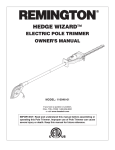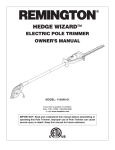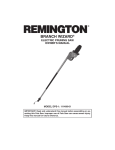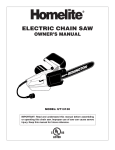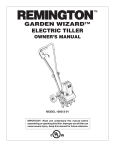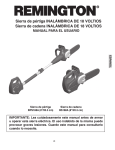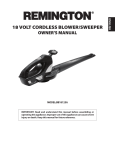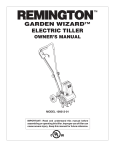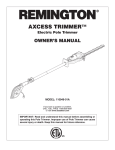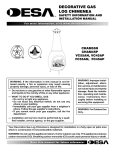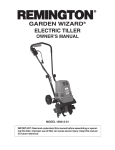Download Remington 500V User's Manual
Transcript
® Power Pro™ Semi-automatic NDENT LAB OR PE DE ST ® I FO R P U B LI C ™ Y TE NG FE T AN Y OR AT IN Model 500V SA POWDER ACTUATED TOOL MANUFACTURERS´ INSTITUTE INC. G 028 G 029 Operating Instructions 482-1 IMPORTANT: Read this manual and all labels carefully before operating your powder actuated tool. This manual should always accompany the tool and be transferred with it upon change of ownership. INDEX Warning: Safety Precautions ............................................................ 3-11 Why A Power Fastener Holds ............................................................. 12 Selecting Power Fasteners and Power Loads .................................... 13 Operation ....................................................................................... 14-15 Parts List ........................................................................................ 16-17 Cleaning and Maintenance ................................................................. 17 Tool Disassembly ........................................................................... 18-21 Tool Assembly ................................................................................ 22-25 Troubleshooting Guide ........................................................................ 26 Replacement Parts and Accessories .................................................. 27 Technical Service ................................................................................ 27 Repair Service ..................................................................................... 27 Parts Centrals ..................................................................................... 28 Fasteners ............................................................................................ 28 Application Chart ................................................................................. 29 Warranty ................................................................................ Back Cover REMINGTON® Power Pro™ Semi-automatic Model 500V The Remington® Power Pro™ Model 500V is designed for use with Remington® .27 caliber power load strips and Remington® power fasteners which are no longer than 3". Remington® power fasteners are manufactured from special steel and heat treated to produce a very hard yet ductile fastener. Maximum 3" Spall Shield Power Fastener* Power Indicator Adjustment Wheel Barrel Assembly Trigger 10-Shot Power Load Strip* *Not supplied with tool 2 Muzzle/ Guide Recommended Approved Goggles 106763 Warning: Safety Precautions IMPORTANT: Read these operating instructions carefully and completely before trying to operate or service this tool. Improper use of this tool can cause serious injury or death from firing fastener into body or from flying debris. We expressly disclaim any liability for any injury to persons or damage to property which result from your failure to take the precautions contained in this manual. WARNING: This tool is designed only for use by qualified operators. Qualification is obtained through a thorough understanding of the Safety Warnings and operating instructions as defined in this operating manual. NOTE: The labor regulations of many states require that the operator of this tool on a job site be thoroughly trained and certified for competence prior to operating this tool. For certification procedures, call: DESA Specialty Products™ Technical Services Department, 1-800-858-8501 or visit www.desatech.com (U.S.A.) or 1-905-826-8010 (Canada). BEFORE USING 1. ALWAYS handle the tool as if it were loaded. Before starting work, check that the tool is unloaded and the muzzle is clear. NEVER load a tool unless it is going to be used. DEF ECT 2. IVE ALWAYS inspect to make sure the tool is working properly. If the tool does not work properly, remove from service and tag “DEFECTIVE.” DO NOT use the tool again until it has been properly repaired. G 018 3. Operators and bystanders must ALWAYS wear goggles and hearing protection which meet or exceed the accepted standards for adequate protection in your country. In the USA, refer to ANSI standards. In Canada, refer to CSA standards. Continued 106763 3 Safety Precautions WARNING POWDER ACTUATED TOOLS IN USE ! 4. ALWAYS clear the work area on all sides and post appropriate warning signs on job sites. G 018 5. ALWAYS make sure the work area is clean from loose material and debris. HANDLING THE TOOL G 018 1. NEVER place your hand over the muzzle. Accidental discharge can cause serious injury. G 018 2. NEVER place your finger on the trigger until the tool’s muzzle is against the work surface. 4 106763 Safety Precautions POWD POW DER LOAD LOA DS G 018 3. ALWAYS store UNLOADED powder actuated tool and power loads in a locked container. Keep power loads of different power levels in separate containers. G 018 4. NEVER carry or pass a loaded powder actuated tool. NEVER point a powder actuated tool at anyone. G 018 5. If the tool is dropped, inspect for damage and repair it before continuing to work. NEVER use a damaged tool. G 018 6. ALWAYS take precaution to maintain your balance while operating a powder actuated tool. Continued 106763 5 Safety Precautions ? ? ? G 018 7. An operator taking medication should take extra precautions while handling the tool. NEVER drink alcoholic beverages or take medications which impair your vision, balance or judgement before using a powder actuated tool. KNOW YOUR FASTENING BASE MATERIAL ? ? ? ? Sinks in with average hammer blow CENTER PUNCH TEST G 018 TOO SOFT Surface shatters Point flattens TOO BRITTLE G 018 TOO HARD G 018 1. ALWAYS know the thickness and type of base material into which you are fastening. NEVER GUESS. Test the base material by using the Center Punch Test. The Center Punch Test is performed by using a hammer to test drive the particular power fastener to be used into the material. If the point penetrates easily, the material is too soft. If the point becomes blunt, the material is too hard. If the material fractures, cracks or shatters, the material is too brittle. Test fastenings can be made if the material shows a clear fastener impression and the fastener point is not blunted. ALWAYS use test fastenings to determine the correct power load level and the tool’s power indicator setting (see Power Loads and Power Indicator Setting, page 13). Operators and bystanders must always wear goggles and ear protection which meet or exceed the accepted standards for adequate protection in your country. In the USA, refer to ANSI standards. In Canada, refer to CSA standards. 6 106763 Safety Precautions TILE CAST IRON BRICK GLASS G 018 G 018 482-33 2. NEVER attempt to drive power fasteners into very hard or brittle materials including, but not limited to cast iron, glass, tile, stone, brick, or hardened steel. Materials of this type tend to shatter and create hazards from flying particles. G 018 3. NEVER make fastenings in spalled or cracked areas. G 018 4. NEVER drive power fasteners into thin or easily penetrated materials unless it is backed by concrete or steel. When in doubt, such as when base material is concealed, conduct a Center Punch Test (See page 6). Check continually to avoid fastening into unsuitable material, especially in older buildings. G 018 5. DO NOT fasten through or within 1/2" of predrilled or pre-punched holes. Continued 106763 7 Safety Precautions 3" 3" 3" 3" 1X 3X 6. DO NOT drive power fasteners into concrete less than three times as thick as the intended fastener penetration, within 3" of the edge, within 3" of another power fastener or within 3" of a failed power fastener. WELD 1" 1/2" TOO THIN G 018 7. 3/16" MIN DO NOT drive power fasteners into steel base material less then 3/16" thick, within 2" of a weld, within 1/2" of the edge or within 1" of another power fastener. G 018 8. When fastening into masonry walls, always drive into horizontal mortar joints, never into vertical mortar joints. BE CAREFUL. A poorly laid joint may permit too much penetration, and/or unsatisfactory holding power. OPERATING THE TOOL 1. ALWAYS hold tool perpendicular to work surface. 8 106763 Safety Precautions WATER 2. Should the tool fail to fire, hold the muzzle firmly against the work surface for 30 seconds. Release the trigger and remove pressure on the tool while holding the muzzle against the work surface. Again press the tool firmly against the work surface and pull the trigger. If the tool still fails to fire, hold the tool firmly against the work surface for another 30 seconds before advancing the power load strip. Use remaining loads in strip. Discard power load strip into water or oil. Spall Shield G 018 3. ALWAYS use the spall shield when driving directly into concrete or steel. Always wear goggles. GAS GASOLINE OLINE G 018 G 018 4. NEVER use a powder actuated tool in an explosive or flammable atmosphere or when non-sparking tools are required. POWER LOADS AND FASTENERS POWER LOADS POWE R LOADS G 018 1. G 018 NEVER leave unfired power load strips on floors or work surfaces. Continued 106763 9 Safety Precautions 22 27 CALIBER Start 6 BRASS YELLOW POWER LEVEL 4 5 4 3 2 7 1 1 RED POWER LEVEL 5 2. NOTE: Failure to start with the lowest power level can result in overdrive condition and will result in damage to tool (See page 13). Remington® power load strips are available in three power levels – green (level 3), yellow (level 4) and red (level 5). Green is lowest power level, red is highest power level. Always use test fastenings to determine the correct power load level and the tool’s power indicator setting (see Power Loads and Power Indicator Setting, page 13). IMPORTANT: Purple (level 6) power load strips will not function in model 500V tool. G 018 3. 8 9 10 11 12 NICKEL GREEN POWER LEVEL 3 G 018 NEVER use power loads in firearms. POWER POWER LOAD LOADS STRIPS ONLY ONLY 4. NEVER carry fasteners or other hard objects in the same pocket or container with power load strips. G 018 5. A color blind person must take extra precautions to prevent the chance of mixing the power load strips of various levels. 10 106763 Safety Precautions G 018 6. Power fasteners are a permanently installed fixture. An act of demolition is required for their removal. Appropriate safety precautions must be taken. Head Shank Plastic Flute 7. Never use common nails or other materials as fasteners. Remington® Power Fasteners are manufactured from special steel and heat treated to produce a very hard yet ductile fastener. G 018 8. Never pry a power load out of the strip. Prying can discharge the load causing serious injury (See Troubleshooting Guide, page 26). Never attempt to reload used strips. 9. If work is interrupted for any reason, remove the power load strip before removing the power fastener. 106763 11 Why A Power Fastener Holds WHY A POWER FASTENER HOLDS IN CONCRETE The compression bond of the concrete to the power fastener accounts for the majority of the holding power. The fastener displaces the concrete which tries to return to its original form causing a squeezing effect. Maximum holding power is achieved when the depth of penetration produces a bond on the power fastener equal to the strength of the concrete. As a general rule, penetration should be approximately 1" to 1 1/4" into the base concrete. Make sure the concrete is at least three times as thick as the intended fastener penetration. Never have the power fastener point protrude through the concrete. NOTE: Concrete needs to cure for 28 days before maximum fastening holding power will be achieved. WHY A POWER FASTENER HOLDS IN STEEL Holding power in steel depends on the elasticity of the steel. The steel pushes back on the shank of the power fastener. Drop a marble into water; the water parts, the marble continues down, the water closes back. This is similar to the reaction when a power fastener penetrates steel. In steel, the point of the power fastener must penetrate completely through for highest holding power. If the fastener does not penetrate, the spring action of the steel pushes back on the point and tends to force the fastener out. Recommended applications are between 3/16-3/8" steel. NOTE: When fastening in steel be sure the point goes through the steel. 12 106763 Selecting Power Fasteners and Power loads FASTENING INTO CONCRETE The proper power fastener length can be determined by adding the thickness of the material to be fastened and the amount of fastener that will actually penetrate the concrete. The concrete must be three times as thick as the intended fastener penetration. In most cases, penetration should be approximately 1" to 1 1/4" into the base concrete material. Wood or Non-Metals To Concrete FASTENING INTO STEEL The proper fastener length can be determined by adding the thickness of the material to be fastened and the thickness of the steel. The point of the power fastener must go completely through the steel. Wood or Non-Metals To Steel POWER LOADS AND POWER INDICATOR SETTING Proper fastening requires the correct combination of power load level and the tool’s power indicator setting to match the fastener length for a given application. A general estimate for the power load level needed for a given application can be found in the application chart on page 29. For a given power load level, always start with the lowest power indicator setting on the tool. If the first test fastening does not penetrate to the desired depth, increase the tool’s power indicator setting until a proper fastening is made. IMPORTANT: Damage to the tool will result if the above instructions are not followed (see illustrations to right and lower right). OVERDRIVEN POWER FASTENERS AND PISTON An overdriven power fastener results when the combination of power load level and the tool’s power indicator setting is too strong causing the piston to extend past the muzzle. Decrease the tool’s power indicator setting. Repeated overdrive will damage the tool. By avoiding overdrive, the tool’s life can be extended considerably and costly repairs can be avoided. NOTE: Never fire the tool without a power fastener. This can damage the tool and/or cause possible injury to the operator. 106763 13 RIGHT Flush With Surface OVERDRIVE G 018 Piston Extended Out of Muzzle Operation 1. Grasp barrel assembly and slide forward rapidly until it stops. Push barrel assembly back into tool to the closed position. This sets piston into firing position. 2. Insert power fastener into muzzle of tool, head end first. Push the fastener until point is even with end of muzzle. NOTE: Failure to start with the proper power level and power setting can result in overdrive condition and will result in damage to tool (See page 13). 3. Select the proper power level of power load strips and power indicator setting (see Power Loads and Power Indicator Setting, page 13). Always insert power load strips through bottom of handle. Push power load strip in until even with bottom of handle. 4. Place the muzzle of tool perpendicular to work surface without tilting the tool. Push tool against work surface until sliding action of barrel stops. 14 106763 Operation 5. Squeeze trigger to set power fastener. Be sure to keep pressure on tool during this operation. 6. Grasp muzzle cap and slide barrel forward rapidly until it stops. Push barrel assembly back into tool to the closed position. This advances the power load strip and resets the piston for the next fastening. WARNING: Do not depress barrel assembly past the closed position when loading new power fastener. Live power load is in firing position. WATER 7. Should the tool fail to fire, hold the muzzle firmly against the work surface for 30 seconds. Release the trigger and remove pressure on the tool while holding the muzzle against the work surface. Again press the tool firmly against the work surface and pull the trigger. If the tool still fails to fire, hold the tool firmly against the work surface for another 30 seconds before advancing the power load strip. Use remaining loads in strip. Discard power load strip into water or oil. 106763 15 Parts List Key No. Part No. 1 2 3 4 5 6 7 8 9 10 11 12 13 14 15 16 17 18 19 20 21 22 23 24 25 26 27 28 29 30 31 SF901011 450108 SF901800 SF901010 450005 455000 455041 455042 456048 SF901700 SF901600 SF901002 SF901005 SF901301 SF901302 SF901303 SF901205 452220 SF901208 TA4087 SF901105 SF901104 SF901100 301013 SF901106 306012 SF901200 SF901213 SF901403 454037 454100 32 33 34 454034 454033 454035 101320-02 056486 500V Description Housing O-Ring Baffle Assembly Pawl Assembly Trigger Rocker Arm Assembly Rocker Arm Spring Rocker Arm Pin Screw Handle Pad Assembly Rear Pad and Power Indicator Assembly Cover Screw Advance Bar Advance Spring Advance Pin Piston Assembly (Includes Ring) Piston Ring Muzzle Cap Plastic Buffer (5 Pack) Transfer Pin Push Pin Outer Liner Assembly Ball Detent Annular Spring Key Stop Barrel Power Adjustment Pin and Ring Spring Firing Pin Spring Firing Pin Assembly (Includes Pin, Spring, Washer, and Screw) Sear Spring Sear Firing Pin Guide Optional Accessory Spall Shield Brush Qty. 1 1 1 1 1 1 1 1 2 1 1 1 2 1 1 1 1 1 1 1 1 1 1 1 1 1 1 1 1 1 1 1 1 1 1 1 IMPORTANT: Do not use key numbers when ordering service parts. Always order components by part number and description. Include model number and serial number of tool. 16 106763 Parts List 500V 28 18 27 17 20 19 25 24 23 34 12 26 31 21 14 13 22 15 33 16 32 11 6 9 10 7 4 8 9 30 29 5 1 2 3 Cleaning and Maintenance Clean tool after each days use. Disassemble and clean the barrel assembly with the wire brush provided with tool. Notice: Do not attempt to clean power load strip channel with wire brush. Apply good quality penetrating lubricant spray (such as WD-40) sparingly and wipe dry. 106763 17 Tool Disassembly WARNING: Always unload a powder actuated tool before disassembling, replacing barrel, cleaning, or assembling. A. REMOVING BARREL ASSEMBLY 1. 2. Using screwdriver, lift end of annular spring and rotate spring until key stop is uncovered (see Figure 1). Annular Spring Key Stop Figure 1 - Rotating Annular Spring to Uncover Key Stop Push key stop towards rear of tool and remove (see Figure 2). Key Stop 3. 4. 5. Figure 2 - Removing Key Stop Firmly grip and pull barrel assembly from the outer liner assembly. Unscrew muzzle cap. Pull plastic buffer out of muzzle cap (see Figure 3). Barrel Assembly Plastic Buffer Muzzle Cap Piston 6. Outer Liner Assembly Figure 3 - Separating Barrel Assembly from Housing Pull piston assembly, using moderate force, from barrel (see Figure 4). Piston Assembly Barrel Figure 4 - Removing Piston Assembly from Barrel 18 106763 B. REMOVING HANDLE PAD ASSEMBLY 1. 2. Loosen screw on back of handle pad assembly with 3mm hex wrench. Do not remove the screw from the assembly (see Figure 5). Remove handle pad assembly. Handle Pad Assembly 3mm Hex Wrench Figure 5 - Removing Handle Pad Assembly C. REMOVING REAR PAD AND POWER INDICATOR ASSEMBLY 1. 2. Keeping pressure against the back of the rear pad and power indicator assembly, loosen screws using a 3mm hex wrench. Slowly release pressure. Note: Rear pad and power indicator assembly is spring loaded. Pressure should be kept on the assembly at all times while loosening screws to avoid loosing parts. Pull rear pad and power indicator assembly out of housing (see Figure 6). Screws Rear Pad and Power Indicator Assembly Housing Figure 6 - Removing Rear Pad and Power Indicator Assembly D. REMOVING ROCKER ARM ASSEMBLY 1. 2. 3. Remove the larger spring from the outside of the outer liner assembly and the firing pin spring from inside the outer liner assembly (see Figure 7). Remove rocker arm pin with hammer and punch. Remove rocker arm assembly from housing (see Figure 7). Rocker Arm Assembly Rocker Arm Spring Housing Rocker Arm Pin Firing Pin Spring Spring Figure 7 - Removing Rocker Arm Assembly from Housing Continued 106763 19 Tool Disassembly (Cont.) E. REMOVING FIRING PIN 1. 2. 3. 4. Slide firing pin guide back so the slot in the firing pin guide lines up with the slot in the outer liner assembly. Pull the sear out of the aligned holes (see Figure 8). Slide firing pin guide off of the outer liner assembly (see Figure 9). Pull the firing pin assembly with sear spring out of the outer liner assembly. Remove sear spring from firing pin assembly (see Figure 9). Remove transfer pin and push pin from outer liner assembly (see Figure 9). Sear Outer Liner Assembly Sear Spring Firing Pin Guide Firing Pin Guide Transfer Pin Push Pin Outer Liner Assembly Firing Pin Assembly Figure 8 - Removing Sear Figure 9 - Removing Firing Pin Guide, Firing Pin Assembly, Sear Spring, Transfer Pin, and Push Pin F. REMOVING TRIGGER AND PAWL ASSEMBLY 1. 2. Slide trigger out of housing (see Figure 10). Using a phillips head screw driver, loosen screw and remove pawl assembly components from housing (see Figure 10). Housing Pawl Assembly Trigger Figure 10 - Removing Trigger and Pawl Assembly 20 106763 G. REMOVING ADVANCE BAR 1. 2. 3. Using a 3mm hex wrench, loosen screws on cover and remove. Remove advance pin with hammer and punch. Remove advance bar and spring. Advance Bar and Spring Screws Cover Housing Advance Pin Figure 11 - Removing Advance Bar H. REMOVING BAFFLE ASSEMBLY 1. Loosen and remove baffle assembly and o-ring. Housing Handle O-Ring Baffle Assembly Figure 12 - Removing Baffle I. REMOVING OUTER LINER ASSEMBLY FROM HOUSING 1. Grasp outer liner assembly and firmly pull from housing. Outer Liner Assembly Housing Figure 13 - Removing Outer Liner Assembly Tool Assembly WARNING: Always unload a powder actuated tool before disassembling, replacing barrel, cleaning, or assembling. A. INSERTING OUTER LINER ASSEMBLY 1. Firmly push outer liner assembly into housing (see Figure 14). Housing Outer Liner Assembly Figure 14 - Inserting Outer Liner Assembly Continued 106763 21 Tool Assembly (Cont.) B. INSERTING BAFFLE ASSEMBLY 1. Insert baffle assembly with o-ring into handle and tighten (see Figure 15). Housing Handle O-Ring Baffle Assembly Figure 15 - Inserting Baffle Assembly C. REPLACING ADVANCE BAR 1. 2. 3. Place advance bar and spring into housing (see Figure 16). Secure advance bar by inserting the advance pin through the housing, advance bar, and spring. Place cover onto housing and align holes. Insert screws into cover and tighten with 3mm hex wrench (see Figure 16). Advance Bar and Spring Screws Cover Housing Advance Pin Figure 16 - Replacing Advance Bar D. REPLACING TRIGGER AND PAWL ASSEMBLY 1. 2. Assemble pawl components and screw into housing using a phillips head screwdriver (see Figure 17). Slide trigger into housing (see Figure 17). Housing Note: Spring and plate are NOT reversible. Bent arm on spring must be toward plate. Pawl Assembly Trigger Figure 17 - Replacing Trigger and Pawl Assembly 22 106763 E. REPLACING FIRING PIN 1. 2. 3. Insert transfer pin and push pin into outer liner assembly (see Figure 18). Place sear spring into firing pin assembly. Slide firing pin assembly into outer liner assembly (see Figure 18). Slide the firing pin guide onto the outer liner assembly. Align the holes in the firing pin guide, the outer liner assembly, and firing pin assembly so that the sear can pass easily through all three (see Figure 19). Depress sear spring with sear and slide the sear and firing pin guide toward the front of the tool. Outer Liner Assembly Sear Sear Spring Firing Pin Assembly Firing Pin Guide Firing Pin Guide Transfer Pin Push Pin Outer Liner Assembly Figure 18 - Replacing Firing Pin Guide, Firing Pin Assembly, Spring, Transfer Pin, and Push Pin Figure 19 - Replacing Sear F. REPLACING ROCKER ARM ASSEMBLY 1. 2. 3. Place rocker arm assembly, with rocker arm spring attached, into housing. The rocker arm assembly will sit on top of the firing pin guide. Push rocker arm pin through the housing and rocker arm assembly with a punch and hammer. Insert firing pin spring into outer liner assembly. Slide larger spring onto the outer liner assembly. Rocker Arm Assembly Sear Firing Pin Guide Rocker Arm Spring Housing Firing Pin Guide Firing Pin Spring Rocker Arm Pin Spring Figure 20 - Replacing Rocker Arm Assembly into Housing Continued 106763 23 Tool Assembly (Cont.) G. ATTACHING REAR PAD ASSEMBLY 1. 2. Push the rear pad and power indicator assembly onto housing, aligning screws with holes in housing. Holding pressure on rear pad and indicator assembly, tighten screws with 3mm hex wrench. Note: Rear pad and power indicator assembly is spring loaded. Pressure should be kept on the assembly at all times while tightening screws to avoid loosing parts. Screws Rear Pad and Power Indicator Assembly Housing Figure 21 - Attaching Rear Pad and Power Indicator Assembly H. ATTACHING HANDLE PAD ASSEMBLY 1. Place handle pad assembly onto housing body and tighten screw with 3mm hex wrench. Make sure rocker arm spring stays tight against the handle pad assembly while tightening screw. Rocker Arm Spring Handle Pad Assembly 3mm Hex Wrench Figure 22 - Attaching Handle Pad Assembly I. ASSEMBLING BARREL ASSEMBLY 1. Using moderate force, insert piston assembly into barrel (see Figure 23). Piston Assembly Barrel Figure 23 - Inserting Piston Assembly into Barrel 24 106763 2. 3. 4. Insert plastic buffer into muzzle cap. Screw muzzle cap to barrel assembly. Firmly insert barrel into outer liner assembly with slot side down (see Figure 24). Barrel Assembly Plastic Buffer Muzzle Cap Outer Liner Assembly Piston Figure 24 - Separating Barrel Assembly from Housing 5. 6. 7. Insert key stop into slot on outer liner assembly (see Figure 25). Push stop towards front of tool (see Figure 25). Rotate annular spring until key stop is covered (see Figure 26). Key Stop Figure 25 - Replacing Key Stop Annular Spring Key Stop Figure 26 - Rotating Annular Spring to Cover Key Stop 106763 25 Troubleshooting Guide PROBLEM POSSIBLE CAUSE REMEDY Piston hangs out of muzzle. Tool overdriven. Tap piston on hard surface until piston is pushed back into the guide. (See Over-driven Fastener below). Piston not properly assembled in relation to stop. Remove barrel assembly (see pages 18-21). Replace all damaged or missing parts. Broken piston or piston ring. Replace piston or piston ring or take tool to your distributor. Overdriven fastener. Excessive power. Change to next lower power indicator setting and/or power load level (see page 13) or use next longer length fastener. Piston jammed. Overdriving of fastener (see above). Remove barrel assembly (see pages 18-21). Replace other parts if damaged. Power load strip will not advance. Advance bar or spring damaged Replace advance bar or springs. Tool dirty. Clean tool. Notice: Do not attempt to clean power load strip channel with wire brush. You may damage tool. Piston not returning to full rear position. Barrel must be opened to the full extended position to properly position piston. Worn piston ring or broken piston. Replace piston and/or piston ring or take tool to your distributor. Tool does not completely depress. Misassembled or damaged sear, firing pin parts, or guide. Remove firing pin guide and check all parts for correct fit assembly. Tool does not fire. Failure of tool to depress completely. See data listed under Tool does not completely depress, above. Piston not fully reset. Fully reset piston. See step 1 under Operation, pages 14 and 15. Dirt buildup on sear not allowing proper penetration of firing pin or worn firing pin. Check firing pin mark on power load. Clean firing pin guide, sear and firing pin. Replace worn or damaged parts. Notice: Do not attempt to clean power load strip channel with wire brush. You may damage tool. Lack of proper cleaning. Inspect and clean complete tool. Replace worn or damaged parts. Notice: Do not attempt to clean power load strip channel with wire brush. You may damage tool. Reduction or loss of power. Opening and closing of barrel or pushing down on tool, etc. is not smooth but is rough or binds. 26 106763 Replacement Parts And Accessories WARNING: Use only replacement parts and accessories described in this manual. Use of other parts or accessories could damage saw or injure operator. For original replacement parts and accessories, contact your nearest Authorized Dealer or Authorized Service Center for this product. If they can not supply the part or accessory, contact your nearest Parts Central listed on page 28. Each Authorized Dealer, Authorized Service Center, and Parts Central is independently owned and operated. See pages 16 and 17 for an Illustrated Parts List. If you need additional referral information, contact our Technical Service Department (see Technical Service). In Canada call 1-800-561-3372 for parts information. Technical Service You may have further questions about assembling, operating, or maintaining this product. If so, you can visit our Technical Service web site at www.desatech.com or contact our Technical Service Department at 1-800-858-8501 (English Only). You may also write to: DESA Specialty Products™ P.O. Box 90004 Bowling Green, KY 42102-9004 ATTN: Technical Service Specialty Products When contacting DESA Specialty Products™, have ready • Your Name • Your Address • Your Phone Number • Model Number of Product • Date of Purchase (Include copy of receipt for written requests). Repair Service Note: Only use original replacement parts. This will protect your warranty coverage for parts replaced under warranty. Each Authorized Service Center is independently owned and operated. WARRANTY SERVICE If product requires warranty service, return it to nearest Authorized Service Center. You must show proof of purchase. If faulty materials or workmanship caused damage, we will repair or replace product without charge. Note: Normal wear, misuse, abuse, neglect, or accidental damage is not covered under warranty. NON-WARRANTY SERVICE If product requires service, return it to nearest Authorized Service Center. Repairs will be billed to you at regular repair list prices. For additional Service Center or warranty information, call 1-800-858-8501 or visit our Technical Service web site at www.desatech.com. 106763 27 Parts Centrals Ray’s Portable Heater Service 3191 Myers Road Camino, CA 95709-9550 530-644-7716 Baltimore Electric 5 Manila Drive Hamden, CT 06514-0322 203-248-7553 1-800-397-7553 Eckley’s Small Engine 31617 Spruce Drive Eustis, FL 32726-9592 352-357-6764 Parts Company of America 1657 Shermer Road Northbrook, IL 60062-5362 708-498-5900 1-800-323-0620 www.grainger.com Portable Heater Parts 342 North County Road 400 East Valparaiso, IN 46383-9704 219-462-7441 1-800-362-6951 www.portableheaterparts.com [email protected] [email protected] FBD 1349 Adams Street Bowling Green, KY 42103-3414 270-846-1199 1-800-654-8534 [email protected] Lyons & Lyons Sales Co. Inc. Glen Arm Road Glen Arm, MD 21057-9454 410-665-6500 1-800-333-5966 [email protected] Master Part Distributors 1251 Mound Avenue NW Grand Rapids, MI 49504-2672 616-791-0505 1-800-446-1446 www.masterparts.net Hance Distributors, Inc. 12795 16th Avenue North Plymouth, MN 55441-4556 763-559-2299 www.hanceco.com Automotive Equipment Service 3117 Holmes Kansas City, MO 64109-1716 816-531-9144 1-800-843-3546 www.aes-lawnparts.com Bowden Electric Motor Service 1681 S. Wesleyan Blvd. Rocky Mount, NC 27803 252-446-4203 East Coast Energy 10 East Route 36 West Long Branch, NJ 07764-1501 1-800-755-8809 Forrest Lytle and Sons, Inc. 740 West Galbraith Road Cincinnati, OH 45231-6002 513-521-1464 Bortz Chain Saw Shop Road #2, Box 64A Oley, PA 19547-9412 610-987-6452 21st Century 2950 Fretz Valley Road Perkasie, PA 18944-4034 215-795-0400 1-800-325-4828 Laportes 2444 N 5th Street Hartsville, SC 29550-7704 843-332-0191 MTA Distributors 555 Hickory Hills Blvd. Nashville, TN 37189-9244 615-299-8777 1-800-264-0225 Webbs Appliance Center 1519 Church Street Nashville, TN 37203-3004 615-329-4079 1-800-899-4079 Industrial Hardware 4109 Bainbridge Blvd. Chesapeake, VA 23324-1403 804-543-2232 1-800-788-0008 [email protected] Mills Lawn and Garden 928 Commonwealth Place Virginia Beach, VA 23464 757-361-9293 www.mills-parts.com Tuco Industrial Products 5223 180th Street SW Suite 4A-1 Lynnwood, WA 98037-4506 425-743-9533 1-800-735-1268 www.tucoheat.com Fasteners 482-79 Wood or Non-Metals To Steel SP FASTENERS 482-80 Wood or Non-Metals To Concrete Fasten wood or nonmetals to concrete or steel. Application Chart Power load and power fastener application information. For fastening this power fastener length to this power load color Two by Fours Concrete Cement Block Steel (3/16" to 3/8" Thick) 2 1/2" 2 1/2" 2" Yellow Yellow Yellow/Red Furring Strips Concrete Cement Block Steel (3/16" to 3/8" Thick) 1 1/2" 1 1/2" 1 1/2" Yellow Yellow Yellow/Red Electrical Junction Boxes Concrete Cement Block Steel (3/16" to 3/8" Thick) 1" 1" 1" Yellow Green Yellow/Red Conduit Clips Concrete Cement Block Steel (3/16" to 3/8" Thick) 1" 1" 1" Yellow Green Yellow/Red Shelf Brackets Concrete Cement Block 1" 1" Yellow Green 1/4" Plywood or Pegboard Concrete Cement Block Steel (3/16" to 3/8" Thick) 1 1/4" 1 1/4" 1 1/4" Yellow Yellow Yellow/Red Power load listings are recommendations only. If you are in doubt, try a test fastening using the next lightest power load. IMPORTANT • Recommended for use with Remington® power load strips and power fasteners. • If power fastener goes below the top surface of the board, use penetrating control disc (* see illustration below). • Always wear approved goggles and hearing protection. *Use power fastener with penetration control disc, part number 015549. 482-90 Load .27 CALIBER Level strip loads for Number powder actuated 3 tools 4 5 Load Strength medium heavy extra heavy Color Code Case Body Head brass brass brass Green Yellow Red NOTES ____________________ ____________________ ____________________ ____________________ ____________________ ____________________ ____________________ ____________________ ____________________ ____________________ ____________________ ____________________ ____________________ ____________________ ____________________ ____________________ ____________________ ____________________ 30 106763 NOTES ____________________ ____________________ ____________________ ____________________ ____________________ ____________________ ____________________ ____________________ ____________________ ____________________ ____________________ ____________________ ____________________ ____________________ ____________________ ____________________ ____________________ ____________________ 106763 31 Limited Warranty Agreement DESA Specialty Products™ warrants the Remington® Power Pro™ Model 500V against defects in materials and workmanship for a period of one (1) year from the date of purchase. If within one (1) year from the purchase date this Powder Actuated Tool fails due to a defect in material or workmanship, DESA Specialty Products™ will repair or replace the tool at DESA Specialty Products’™ option. To obtain service under this warranty, contact DESA Specialty Products™ at the number/address listed below. You must have the Serial Number, Model Number, date of purchase and indicate the type of problem being experienced. DESA Specialty Products™ will send replacement part(s), repair or replace the tool at DESA Specialty Products’™ option. However, this warranty does not cover failures caused by misusing or abusing the product (for proper use of this product, read and understand the operating instructions in this owners manual). Repairs made because of misuse, abuse, negligence or accident will be charged for at regular repair prices. This express and limited warranty is the only warranty on this product, and to the full extent permitted by law there are no other warranties, express or implied, including warranties of merchantability and/or fitness for a particular purpose which extend beyond the terms of this express and limited warranty. To the full extent permitted by law, the liability of DESA Specialty Products™ for personal injury, property damage or any other damage whatsoever, including consequential and incidental damages, arising from the sale or use of this product shall not exceed the purchase price of this product. This warranty gives you specific legal rights, and you may also have other rights which vary from state to state. For information about this warranty write: P.O. Box 90004 Bowling Green, KY 42102-9004 www.desatech.com U.S.A. ONLY For Technical Assistance on Your Remington® Powder Actuated Tool Or For Certification Procedures, Call Technical Services Department 1-800-858-8501 Or Visit www.desatech.com Printed in Taiwan 106763-01 REV. C 08/03

































